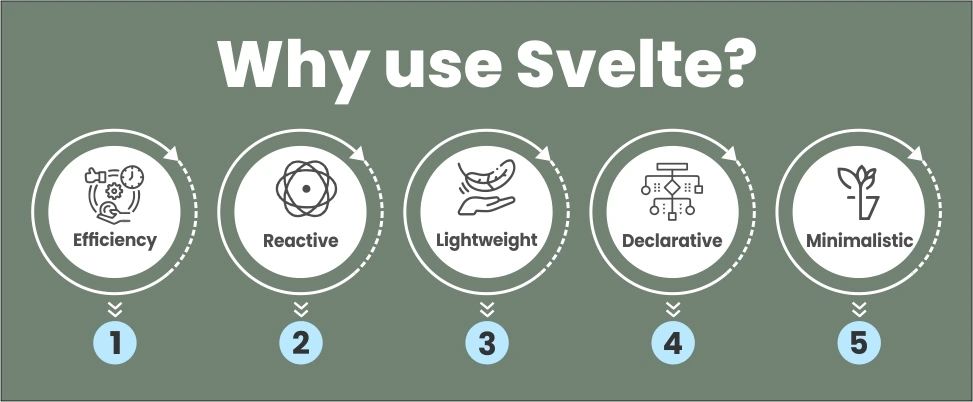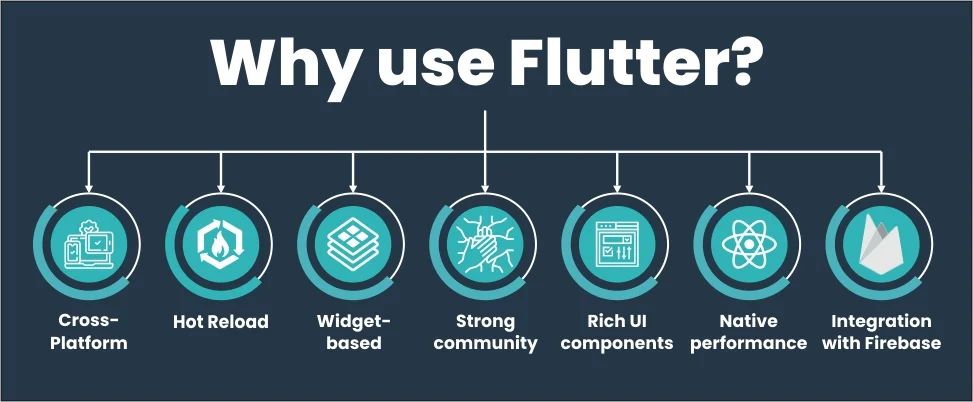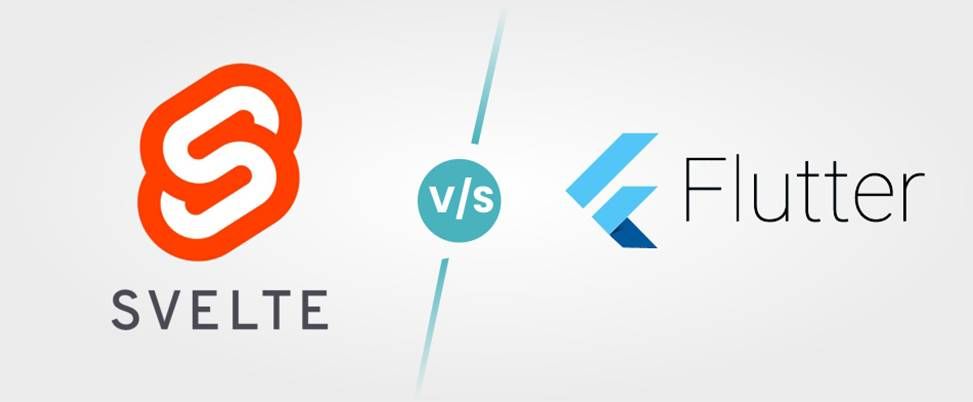Table of Contents
ToggleIntroduction
According to Stack Overflow 2022 survey report, Flutter was one of the popular cross-platform frameworks. It remained in the top three most wanted with 68.03% . Also, the year before, Svelte took the top spot as the most loved framework with 71.47% voting for it. Thus, getting to understand these two relatively new frameworks is essential. Also, a quick comparison between these two newbies will help developers understand these frameworks. Consequently, it will help businesses achieve their goals.
What is Svelte?
Svelte is an open-source lightweight web development framework. It is a free framework developed by Rich Harris in the year 2016. Also, it is currently managed and maintained by the dedicated Svelte core team.
Svelte is a lightweight JavaScript framework designed to build modern web applications.
Svelte smartly shifts most of the heavy lifting from the runtime to the compilation phase. This sets it apart from the other traditional frameworks. The result? Smaller and more efficient applications. Also, its reactive nature empowers developers to create highly interactive user interfaces with less coding.
Svelte: The Lightweight Web Framework

➜ Svelte is an open-source front-end component framework or language. It is a free framework developed by Rich Harris in the year 2016. Also, it is currently managed and maintained by the dedicated Svelte core team.
➜ Svelte is a lightweight JavaScript framework designed to build modern web applications.
➜ Svelte smartly shifts most of the heavy lifting from the runtime to the compilation phase. This sets it apart from the other traditional frameworks. The result? Smaller and more efficient applications. Also, its reactive nature empowers developers to create highly interactive user interfaces with less coding.
Flutter: The Cross-Platform Mobile Software Development Kit

➜ Flutter is a free and open-source UI software development kit (SDK) made by Google.
➜ It allows developers to create applications that work on various platforms using just one codebase. These platforms include various web browsers, Fuchsia, Android, iOS, Linux, macOS, and Windows.
➜ Flutter was first introduced in 2015 and officially released in May 2017.
Read More: Svelte vs React - Which Framework Is Better?
What is Flutter?
Flutter is a free and open-source UI software development kit (SDK) made by Google.
It allows developers to create applications that work on various platforms using just one codebase. These platforms include various web browsers, Fuchsia, Android, iOS, Linux, macOS, and Windows.
Flutter was first introduced in 2015 and officially released in May 2017.
Also read: What Is Flutter Used For?
Comparison of Svelte vs. Flutter
Svelte and Flutter are both popular frameworks, but they serve different purposes and have distinct characteristics. Let’s compare Svelte and Flutter based on their key features and use cases:
| Feature | Svelte | Flutter |
|---|---|---|
| Purpose | Front-end JavaScript framework | UI software development kit (SDK) |
| Platform Support | Web browsers | Web, Android, iOS, Linux, macOS, Windows |
| Language | JavaScript | Dart |
| Compilation | Shifts work to compilation phase | JIT (Development), AOT(Production) |
| Reactivity | Efficient DOM updates on data change | Widget-based reactive programming |
| Use Cases | Lightweight web applications, SPAs, Reusable UI components | Cross-platform mobile apps, Web, Desktop |
| Community | Growing Community | Large and active community |
| Learning Curve | Relatively gentle | Requires learning Dart and widgets |
Search Vetted Software Developer Jobs Online at Olibr.
Purpose and Platform
➜ Svelte is primarily a front-end JavaScript framework designed to build modern web applications. It focuses on creating user interfaces for web browsers.
➜ Flutter is a versatile UI software development kit (SDK) developed by Google. It allows developers to build natively compiled applications for multiple platforms. These platforms include web, mobile (Android and iOS), desktop (Linux, macOS, and Windows), and Fuchsia.
Language
➜ Svelte: uses JavaScript as its primary programming language. Thus, it is a familiar framework for developers already skilled in JavaScript.
➜ Flutter: uses the Dart programming language. It is thus easy to learn and offers benefits like hot reload, enabling rapid development.
Compilation
➜ Svelte shifts much of the work from the runtime to the compilation phase. This results in smaller and more performant applications.
➜ Flutter uses a just-in-time (JIT) compiler during development and an ahead-of-time (AOT) compiler for production. It, thus, ensures fast and efficient performance.
Reactivity and Data Binding
➜ Svelte’s reactive system efficiently updates the DOM when data changes. This, thus, enables smooth and responsive user interfaces with less code.
➜ Flutter provides a reactive and declarative programming model, where widgets automatically update when their underlying data changes.
Use Cases
➜ Svelte is excellent for building lightweight web applications. It also perfect to build single-page applications (SPAs), and reusable UI components.
➜ Flutter is perfect for creating visually stunning and interactive cross-platform mobile applications. Also, they are a great option for web and desktop applications.
Community and Ecosystem
➜ While Svelte’s community is growing, it is relatively newer compared to other frameworks. Moreover, it has an increasing number of libraries and tools available.
➜ Flutter has a large and active community. It, thus, has a rich ecosystem with a wide range of plugins, packages, and resources for various use cases.
Learning Curve
➜ Svelte has a relatively gentle learning curve. Thanks to its straightforward syntax and design. These features make it accessible to developers with different levels of experience.
➜ Flutter may have a steep learning curve. It requires learning Dart. Also, it requires getting familiar with Flutter’s widget-based architecture.

Don't miss out on your chance to work with the best
apply for top global job opportunities today!
Svelte vs. Flutter: Which Framework Is Best for Web Development?
Svelte is a JavaScript web development framework that has gained a lot of traction among web developers. Flutter has earned its name as one of the most highly sought-after cross-platform development software development kits. Let’s have a closer look at the benefits of each of these frameworks to find out which framework is best for web development.
Svelte Compiler Promotes Fast Rendering: Svelte’s compiler can convert the web application into highly optimized JavaScript code. Because of its competitor, there is no relationship with the virtual DOM; thus, it results in fast rendering performance. Even with weak internet connections, it works properly without any delay. Whereas Flutter provides faster app startup times and high performance. It is also popular for offering a great user experience. Flutter is undoubtedly the best if you want to create a web app with a better user experience and high performance.
Svelte Intuitive Syntax: Svelte has a simple and intuitive syntax that allows developers to easily learn and use it. Not only that, but this web development framework also simplifies simple state management. Using a simple assignment statement, it tracks the variables automatically and updates them whenever the state changes. There is no need to deal with the complex state management libraries. On the other hand, Flutter’s rendering engine, Skia, enables smooth animation and responsive user interfaces. Also, when developers use the same code across multiple platforms, it accelerates the development pace.
Component-Based Architecture: Svelte’s component-based architecture promotes code reusability. It also has smaller bundle sizes, which helps improve website loading speeds. Therefore, it is extremely beneficial when it comes to building complex web applications. Flutter’s ahead-of-ime makes web apps perform efficiently. Using dart2js enables the app to have a native appearance; this ensures that when users are using the app, they get a native-like feel.
Even though Flutter can be used to create web and desktop applications, it lacks web support and is considered in the preliminary stage. To build a web application, web support is crucial, and Flutters falls short and lacks some web-specific features. This makes it not a suitable option for creating all web development apps. This leads to the conclusion that, in comparison to Flutter and Svelte, Svelte is best for web development for building web apps.
Conclusion
In conclusion, both Svelte and Flutter are powerful frameworks. However, both cater to different development needs. Svelte stands out for building lightweight and performant web applications. Thanks to its simple syntax and reactive data binding. On the other hand, Flutter excels in crafting visually appealing cross-platform mobile apps. Credit goes to its fast performance and hot reload feature.
When making your choice between Svelte and Flutter, consider the specific requirements of your project. Further, you may also look into the platform you are targeting, and the expertise of your development team. Ultimately, both frameworks have their strengths and can empower developers to create impressive web and mobile applications. So, dive into the details and make an informed decision to bring your visions to life! If you are a Svelte developer looking for top opportunities, sign up with Olibr now
Frequently Asked Questions
The top Flutter app development company in India is HCL Tech, which quickly identifies your needs and solutions.
Flutter online compiler is a code editor that allows users to write and execute code in a browser without the need for a complex setup.
Yes, absolutely. Svelte is the popular JavaScript framework used to build UI for web apps. Its remarkable performance and rising popularity make it relevant in 2023 and beyond.
Svelte is best for smaller projects and a dynamic user interface. Because it is lightweight and uses less code. It is also the best for developers with less experience.
Take control of your career and land your dream job
sign up with us now and start applying for the best opportunities!


